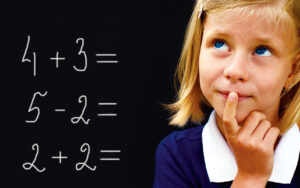There are million-dollar rewards for solving some mathematical problems including to go math 1st grade. And yet they remain unsolved, no matter how hard the best minds fight over them. How does mathematical thought evolve-isn’t everything still proven? And why invest huge sums of money working on abstract problems? Let’s look into the complicated world of mathematics!
Tells the guest of the program “Question of Science”, candidate of physical and mathematical sciences, head of the laboratory of popularization and propaganda of mathematics at the Steklov Mathematical Institute of the Russian Academy of Sciences Nikolai Andreev.
Mathematics is a way to study our world
Mathematics including go math second grade studies our world in its maximum abstraction. Physicists are used to working with manifestations, but mathematicians work with abstraction: they look for those properties of our world purified from manifestations, which can then be studied and applied. There is a terrific article by our great mathematician Manin, entitled “Mathematics as a Language for Describing Possibilities. At the end of his article Yury Manin gives the example of a shaman, who didn’t decide what to do with the tribe, but gave advice to the leader of the tribe on the best way to proceed. Yuri concludes with the following words: “Mathematics describes the phase space of the real world, the space of possibilities. It studies the laws that determine possible trajectories in this phase space, as well as the conditions, the set of information that is required to choose a particular phase trajectory. So it basically tells society that if you do this, you will go this way; if you do that, you will evolve that way. And this is such a higher view of mathematics.
[The Russian mathematician] Alexei Nikolayevich Krylov compares mathematics to a workshop: mathematicians prepare all kinds of tools for various needs. And when mankind has to solve some problem, professors of mathematics – scientists-experts of these tools – give mankind the tool it needs to solve the next problem: sometimes a rough file, sometimes a fine file…
New fields are constantly emerging; mathematics expands a little, and from the new frontiers one can see further fields that can continue to be explored, which will then result in benefits for all of humanity. Here we can give a very simple example – the article “From Lobachevsky’s “crazy” geometry to GPS-navigators”. Here Lobachevsky invented his geometry. He died without even seeing a single working model. And of course, he could not think that later Riemannian geometry would be created. And later, on the basis of Riemannian geometry, Einstein would create his theories of relativity, special and general relativity. And now we, every day using a GPS navigator, use including the general and special theories of relativity. Because if we did not take into account the effects that they give, the error in determining the coordinates on the ground would be huge and the GPS would not be needed. The power of mathematics is that always one way or another these seemingly abstract studies then find their application to mankind.
Does the world only seem mathematical or is it a property of nature?
It is, of course, a property of nature. In general, all mathematicians are Platonists. There’s a little book called “Proof from the Book” – it’s about the fact that somewhere there are written proofs, and we humans can get close to them. And indeed, sometimes you take a proof, it can be very short, but it proves something very important. Actually, the book Proof from the Book itself begins with Euclid’s proof of the existence of an infinite number of prime numbers. A proof that has endured for centuries, and yet is really very beautiful, powerful, and interesting! And sometimes you look and see that there’s still something we don’t know and that’s why the proof is so complicated.
Mathematics dispels the fog – it explores what we haven’t yet explored in our world. It reveals the essence by formalizing and abstracting from something that is already attuned to that essence. And then it remains to apply the resulting laws either to the subject or to the task – it already depends on what humanity needs.
Mathematics Around Us
Let’s talk about those manifestations of mathematics in our surrounding world that everyone understands, and on the other hand, reveal a mathematical approach, a mathematical component.
For example, the cycloidal curve made it possible to create the first isochronous pendulum clock, in which the period of oscillation did not depend on the amplitude. These were the first clocks. Obviously, there’s a lot of math in engineering. Here at school, everyone went over the parabola. But there is an optical property of a parabola, namely, that rays of light passing parallel to the axis of the parabola, after being reflected from it, fall into focus. Parabolic dishes, satellite dishes that look at a satellite, work according to this principle. And here’s a clear, simple example that has to do with high school math.
Or let’s take colors. The way computers provide us with color, how it adds up, it’s all based on mathematics. Just recently we were celebrating the 50th anniversary of the moon landing, the moonwalker’s delivery to the moon. And in 1970, our Soviet lunar program began, and there was a device that we all know, which is a cataphot, an angle reflector. Three planes are mutually perpendicular to each other, and if you shine a beam on them, then after reflection from all three mirrors, the beam goes parallel to the direction from which it came. And it does not matter where you shine from, the beam will come back to you.
Exactly, so out of these little corners, mutually perpendicular to the three planes, make cataphot on a bicycle. And when you car headlights illuminate some cyclist, you see the glow from the cataphot, although there are no bulbs. But you have to be careful – those coming from the right and the left may not see the reflections from the cataphot because the light comes back to you. The same idea of reflection is used at stoplights when the road turns. The exact same cataphot, the same set of corner reflectors, was installed on the moonwalker. And so far, this ongoing experiment in laser locating of the moon allows us to measure the ever-changing distance to the moon to within a few centimeters, maybe even millimeters. And there are only three planes! There is a law in physics: “The angle of incidence equals the angle of reflection” and then comes the math.
Or here is, say, an example we pass by all the time: why are cups made in the shape of a cone? A piece of paper can be made into a cylinder or a cone, so why choose a cone? Because cups of this shape can be inserted into each other, while cylindrical buckets or cups could not be inserted, they would have to be transported separately. It’s the same thing we see when road services come in and set up cones. But a cone is a bendable surface, and just a tapered cup would have been inconvenient to use. It was necessary to give it rigidity. This requires a bagel surface – in mathematics it is called a “torus”. As it turned out, even a small piece of torus, which contains a circle, is a rigid surface. Being made of the same thin plastic, it is an inflexible surface. The question, “Which surfaces are bendable and which are not?” – was an important topic, and it is still an ongoing one for mathematicians. Of course, it wasn’t studied for the sake of cups. But once we learn a property, we can apply mathematical knowledge to different areas.
Proofs as the basis of mathematics
When you’re trying to solve a problem, you have to go through a lot of different options. And mathematics tells you right away that these are the options you can’t even consider. Rigor is the power of mathematics.
In fact, even within mathematics, the concept of proof has varied. In ancient India it was enough to draw a picture with a proof and write, “Look,” and they considered that a proof. It is clear that now such a proof is not even considered, well, only as an illustration. One of the big, important breakthroughs came in the time of Hilbert, who began to systematize proofs.
In 1900, the International Mathematical Congress heard Hilbert’s famous paper in which he posed his famous “Hilbert Problems,” which were very prestigious to solve. And it should be noted that more than half of those solved were solved by members of our institute. And here I will refer readers to an article by Lev Dmitrievich Beklemishev, our academician, it is interestingly called: “Mathematics and Logic.” Indeed, logic is sometimes called the basis of mathematics, because proof is the subject of the study of logic. A lot of things were born out of logic that, again, we don’t even realize are based on logic. For example, databases are one branch of this science. Linguistics also draws heavily on logic.
As we say goodbye, I want to take you back to your childhood. I take in my hands the book “The Mathematical Component”, where we collected all kinds of plots of manifestations of mathematics in our lives, and open it on the page “Arithmetic tricks”.
Guess a number. Have you guessed it?
Add five to it. Did you add it?
Now multiply the result by 2. Have you multiplied it?
Subtract the number you guessed from the result. Have you subtracted it?
Subtract the number again. How much did you get?
I’ll tell you: 10.
Mathematics actually simplifies the way we look at life. If you write down the formula for our trick, it looks very simple. And that makes the point very clear. If schoolchildren were reading us, I would tell them: if you put in a little effort now and learn math, it will be much easier to live later. When formulas were introduced instead of words in Viet’s time, everything became clear and transparent.